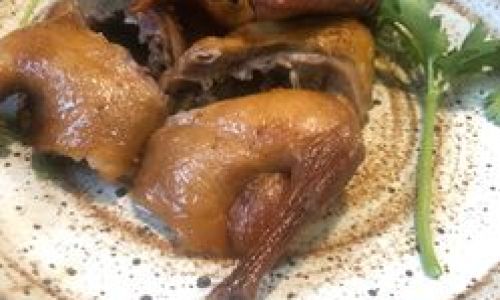Introduction
In the vast realm of culinary arts, traditional recipes often hold a special place, offering a glimpse into the rich tapestry of cultural heritage and gastronomic excellence. Among these timeless delicacies, salt-baked squab stands out as a dish that combines simplicity with sophistication, paying homage to the art of preserving flavors while enhancing the natural beauty of the ingredients. Originating from various parts of Asia, particularly regions with a strong culinary tradition like China, salt-baked squab is a dish that not only satisfies the palate but also captivates the senses with its aromatic allure and visual appeal. This article delves into the intricacies of preparing this exquisite dish, guiding you through each step to ensure a perfect outcome that will delight even the most discerning food enthusiast.
Understanding the Ingredients
Before diving into the preparation, it’s crucial to understand the key ingredients and their roles in creating the perfect salt-baked squab. The star of the dish, of course, is the squab—a young pigeon that offers a tender, moist flesh ideal for roasting or baking. Squabs are highly valued for their delicate taste and nutritional benefits, making them a premium choice for gourmet cuisine.

Salt, the other essential component, serves multiple purposes. It acts as a natural preservative, drawing out moisture from the squab while infusing it with a subtle briny flavor. Additionally, the salt crust creates an insulating layer that protects the meat from direct heat, ensuring even cooking and a juicy interior.
Other ingredients, such as ginger, garlic, spring onions, and various spices, add layers of complexity to the dish, enhancing its aroma and taste. These aromatics not only flavor the squab but also contribute to its overall presentation, making it a feast for both the eyes and the mouth.
Preparing the Squab
-
Selection and Preparation of the Squab:
Begin by selecting fresh, plump squabs. Ideally, they should be cleaned and prepared by a butcher to ensure a neat presentation and remove any unwanted feathers or internal organs. Once you have your squabs, rinse them thoroughly under cold running water and pat them dry using paper towels. This step is crucial as it removes any impurities and ensures that the skin adheres well to the salt crust later. -
Marinating the Squab:
To infuse the squab with flavor, create a marinade using minced ginger, garlic, chopped spring onions, soy sauce, Shaoxing wine (or dry sherry as a substitute), sesame oil, and a pinch of white pepper. Mix these ingredients well and rub them evenly over the squabs, ensuring that every part is well-coated. Allow the squabs to marinate for at least 30 minutes, preferably refrigerated, to allow the flavors to meld and penetrate the meat.
Crafting the Salt Crust

-
Mixing the Salt and Aromatics:
While the squabs are marinating, prepare the salt crust. In a large bowl, combine coarse sea salt with a handful of chopped aromatic vegetables like ginger, garlic, and spring onions. You can also add a few whole spices like star anise, Sichuan peppercorns, and cloves for an extra layer of complexity. Mix these ingredients thoroughly until well combined. -
Forming the Crust:
Take a portion of the salt mixture and spread it evenly on a piece of parchment paper or aluminum foil large enough to wrap the squab. Place the marinated squab on top of the salt layer, ensuring it’s centered. Pack the remaining salt mixture tightly around the squab, forming a thick, even crust. The crust should completely enclose the squab, sealing in all the juices and flavors.
Baking the Salt-Baked Squab
-
Preheating the Oven:
Preheat your oven to 375°F (190°C). This temperature is ideal for slow, even cooking, ensuring that the squab remains moist and tender. -
Baking:
Place the wrapped squab on a baking sheet and bake in the preheated oven for about 45-55 minutes. The exact timing may vary depending on the size of the squab and your oven’s heat distribution. The salt crust will turn a golden brown and harden, indicating that the cooking process is nearly complete.
Serving the Salt-Baked Squab

-
Cracking the Crust:
Carefully remove the baked squab from the oven and let it cool slightly. Using a hammer or the back of a heavy knife, gently crack the salt crust, revealing the beautifully cooked squab within. Be cautious as the steam inside will be hot. -
Serving:
Carefully peel away the salt crust and discard it. The squab should be moist, tender, and infused with the aromatic flavors of the marinade and spices. Serve the squab whole or carved into portions, accompanied by a dipping sauce made from soy sauce, sesame oil, and a touch of chili oil for added zest. Garnish with chopped green onions or fresh cilantro for a burst of color and freshness.
Conclusion
Making salt-baked squab may seem like a labor-intensive process, but the end result is well worth the effort. This dish embodies the essence of traditional culinary wisdom, combining simple ingredients in a way that elevates them to new heights of flavor and texture. Whether you’re hosting a dinner party and looking to impress your guests or simply treating yourself to a gourmet meal at home, salt-baked squab is a dish that promises to deliver an unforgettable culinary experience. With its delicate taste, aromatic scents, and visual appeal, it’s a testament to the art of cooking and the joy of sharing a meal that nourishes both the body and the soul.





0 comments